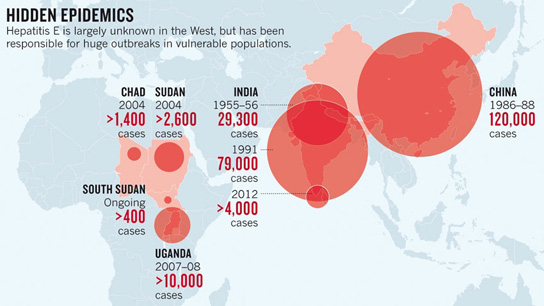
Poor sanitation at the Yusuf Batil refugee camp in South Sudan caused an outbreak of hepatitis E earlier this year. Credit: A. Ohanesian/Reuters
The world’s first vaccine against the hepatitis E virus began being deployed from China last week, promising to stop the propagation of a disease that infects 20 million people yearly and claims 70,000 lives. This vaccine is the result of an unusual public-private partnership in China’s biotechnology sector, and could help deliver other vaccines for diseases that have been overlooked.
Hepatitis E is a waterborne virus that mostly occurs in developing countries with poor sanitation, and is prevalent in east and south Asia. Most cases cause only mild illness, but they can lead to acute liver failure. The mortality rate reaches 4% in some regions and soars to 20% in women who are in the later stages of pregnancy. There was a severe outbreak of hepatitis E in the Xinjiang Uygur Autonomous Region in northwest China that caused almost 120,000 infections and more than 700 deaths between 1986 and 1988.

Sources: J. M. Hughes et al. Clin. Infect. Dis. 51, 328–334 (2010)/who/Promed-mail
The new vaccine was approved by China’s State Food and Drug Administration (SFDA) in December 2011. The development of the vaccine began more than a decade ago but preclinical and clinical development began in earnest only in 2000, when the Yangshengtang Group invested $1.8 million to fund a joint biotech laboratory with the Xiamen University in Fujian province. In 2006, the lab was given national status and relaunched as the National Institute of Diagnostics and Vaccine Development in Infectious Diseases (NIDVD).
The institute’s goal is to unite academia and industry to commercialize new vaccines, particularly for emerging infectious diseases. Hecolin, the hepatitis E vaccine, is the first product to reach the market of this venture, but there is also a vaccine against the human papilloma virus (HPV) that is currently in pre-clinical research. Hecolin was approved after a phase III clinical trial in 2010 showed that it was highly effective in preventing infection among almost 100,000 participants.
Most of the $80 million Hecolin development cost came from the Chinese government. GlaxoSmithKline had already developed a separate hepatitis E vaccine in collaboration with the US Army, but after phase II trials, there was little commercial potential for it.









Be the first to comment on "Hepatitis E Vaccine Debuts Thanks to Chinese Biotech Partnership"